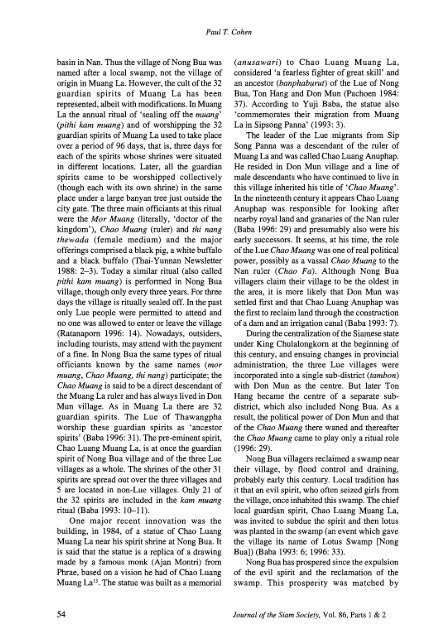The Journal of the Siam Society Vol. LXXXVI, Part 1-2 ... - Khamkoo
The Journal of the Siam Society Vol. LXXXVI, Part 1-2 ... - Khamkoo
The Journal of the Siam Society Vol. LXXXVI, Part 1-2 ... - Khamkoo
Create successful ePaper yourself
Turn your PDF publications into a flip-book with our unique Google optimized e-Paper software.
Paul T. Cohen<br />
basin in Nan. Thus <strong>the</strong> village <strong>of</strong>Nong Bua was<br />
named after a local swamp, not <strong>the</strong> village <strong>of</strong><br />
origin in Muang La. However, <strong>the</strong> cult <strong>of</strong> <strong>the</strong> 32<br />
guardian spirits <strong>of</strong> Muang La has been<br />
represented, albeit with modifications. In Muang<br />
La <strong>the</strong> annual ritual <strong>of</strong> 'sealing <strong>of</strong>f <strong>the</strong> muang'<br />
(pithi kam muang) and <strong>of</strong> worshipping <strong>the</strong> 32<br />
guardian spirits <strong>of</strong> Muang La used to take place<br />
over a period <strong>of</strong> 96 days, that is, three days for<br />
each <strong>of</strong> <strong>the</strong> spirits whose shrines were situated<br />
in different locations. Later, all <strong>the</strong> guardian<br />
spirits came to be worshipped collectively<br />
(though each with its own shrine) in <strong>the</strong> same<br />
place under a large banyan tree just outside <strong>the</strong><br />
city gate. <strong>The</strong> three main <strong>of</strong>ficiants at this ritual<br />
were <strong>the</strong> Mor Muang (literally, 'doctor <strong>of</strong> <strong>the</strong><br />
kingdom'), Chao Muang (ruler) and thi nang<br />
<strong>the</strong>wada (female medium) and <strong>the</strong> major<br />
<strong>of</strong>ferings comprised a black pig, a white buffalo<br />
and a black buffalo (Thai-Yunnan Newsletter<br />
1988: 2-3). Today a similar ritual (also called<br />
pithi kam muang) is performed in Nong Bua<br />
village, though only every three years. For three<br />
days <strong>the</strong> village is ritually sealed <strong>of</strong>f. In <strong>the</strong> past<br />
only Lue people were permitted to attend and<br />
no one was allowed to enter or leave <strong>the</strong> village<br />
(Ratanapom 1996: 14). Nowadays, outsiders,<br />
including tourists, may attend with <strong>the</strong> payment<br />
<strong>of</strong> a fine. In Nong Bua <strong>the</strong> same types <strong>of</strong> ritual<br />
<strong>of</strong>ficiants known by <strong>the</strong> same names (mor<br />
muang, Chao Muang, thi nang) participate; <strong>the</strong><br />
Chao Muang is said to be a direct descendant <strong>of</strong><br />
<strong>the</strong> Muang La ruler and has always lived in Don<br />
Mun village. As in Muang La <strong>the</strong>re are 32<br />
guardian spirits. <strong>The</strong> Lue <strong>of</strong> Thawangpha<br />
worship <strong>the</strong>se guardian spirits as 'ancestor<br />
spirits' (Baba 1996: 31). <strong>The</strong> pre-eminent spirit,<br />
Chao Luang Muang La, is at once <strong>the</strong> guardian<br />
spirit <strong>of</strong> Nong Bua village and <strong>of</strong> <strong>the</strong> three Lue<br />
villages as a whole. <strong>The</strong> shrines <strong>of</strong> <strong>the</strong> o<strong>the</strong>r 31<br />
spirits are spread out over <strong>the</strong> three villages and<br />
5 are located in non-Lue villages. Only 21 <strong>of</strong><br />
<strong>the</strong> 32 spirits are included in <strong>the</strong> kam muang<br />
ritual (Baba 1993: 10-11).<br />
One major recent innovation was <strong>the</strong><br />
building, in 1984, <strong>of</strong> a statue <strong>of</strong> Chao Luang<br />
Muang La near his spirit shrine at Nong Bua. It<br />
is said that <strong>the</strong> statue is a replica <strong>of</strong> a drawing<br />
made by a famous monk (Ajan Montri) from<br />
Phrae, based on a vision he had <strong>of</strong> Chao Luang<br />
Muang La 13 • <strong>The</strong> statue was built as a memorial<br />
(anusawari) to Chao Luang Muang La,<br />
considered 'a fearless fighter <strong>of</strong> great skill' and<br />
an ancestor (banphaburut) <strong>of</strong> <strong>the</strong> Lue <strong>of</strong> Nong<br />
Bua, Ton Hang and Don Mun (Pachoen 1984:<br />
37). According to Yuji Baba, <strong>the</strong> statue also<br />
'commemorates <strong>the</strong>ir migration from Muang<br />
La in Sipsong Panna' (1993: 3).<br />
<strong>The</strong> leader <strong>of</strong> <strong>the</strong> Lue migrants from Sip<br />
Song Panna was a descendant <strong>of</strong> <strong>the</strong> ruler <strong>of</strong><br />
Muang La and was called Chao Luang Anuphap.<br />
He resided in Don Mun village and a line <strong>of</strong><br />
male descendants who have continued to live in<br />
this village inherited his title <strong>of</strong> 'Chao Muang'.<br />
In <strong>the</strong> nineteenth century it appears Chao Luang<br />
Anuphap was responsible for looking after<br />
nearby royal land and granaries <strong>of</strong> <strong>the</strong> Nan ruler<br />
(Baba 1996: 29) and presumably also were his<br />
early successors. It seems, at his time, <strong>the</strong> role<br />
<strong>of</strong> <strong>the</strong> Lue Chao Muang was one <strong>of</strong> real political<br />
power, possibly as a vassal Chao Muang to <strong>the</strong><br />
Nan ruler (Chao Fa). Although Nong Bua<br />
villagers claim <strong>the</strong>ir village to be <strong>the</strong> oldest in<br />
<strong>the</strong> area, it is more likely that Don Mun was<br />
settled first and that Chao Luang Anuphap was<br />
<strong>the</strong> first to reclaim land through <strong>the</strong> construction<br />
<strong>of</strong> a dam and an irrigation canal (Baba 1993: 7).<br />
During <strong>the</strong> centralization <strong>of</strong> <strong>the</strong> <strong>Siam</strong>ese state<br />
under King Chulalongkom at <strong>the</strong> beginning <strong>of</strong><br />
this century, and ensuing changes in provincial<br />
administration, <strong>the</strong> three Lue villages were<br />
incorporated into a single sub-district (tambon)<br />
with Don Mun as <strong>the</strong> centre. But later Ton<br />
Hang became <strong>the</strong> centre <strong>of</strong> a separate subdistrict,<br />
which also included Nong Bua. As a<br />
result, <strong>the</strong> political power <strong>of</strong> Don Mun and that<br />
<strong>of</strong> <strong>the</strong> Chao Muang <strong>the</strong>re waned and <strong>the</strong>reafter<br />
<strong>the</strong> Chao Muang came to play only a ritual role<br />
(1996: 29).<br />
Nong Bua villagers reclaimed a swamp near<br />
<strong>the</strong>ir village, by flood control and draining,<br />
probably early this century. Local tradition has<br />
it that an evil spirit, who <strong>of</strong>ten seized girls from<br />
<strong>the</strong> village, once inhabited this swamp. <strong>The</strong> chief<br />
local guardian spirit, Chao Luang Muang La,<br />
was invited to subdue <strong>the</strong> spirit and <strong>the</strong>n lotus<br />
was planted in <strong>the</strong> swamp (an event which gave<br />
<strong>the</strong> village its name <strong>of</strong> Lotus Swamp [Nong<br />
Bua]) (Baba 1993: 6; 1996: 33).<br />
Nong Bua has prospered since <strong>the</strong> expulsion<br />
<strong>of</strong> <strong>the</strong> evil spirit and <strong>the</strong> reclamation <strong>of</strong> <strong>the</strong><br />
swamp. This prosperity was matched by<br />
54<br />
<strong>Journal</strong> <strong>of</strong> <strong>the</strong> <strong>Siam</strong> <strong>Society</strong>, <strong>Vol</strong>. 86, <strong>Part</strong>s I & 2

















